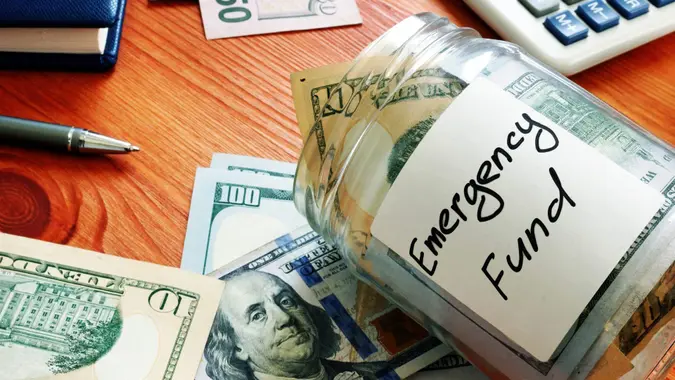Financial Expert: Why 3% Inflation Still Hurts Your Savings

Commitment to Our Readers
GOBankingRates' editorial team is committed to bringing you unbiased reviews and information. We use data-driven methodologies to evaluate financial products and services - our reviews and ratings are not influenced by advertisers. You can read more about our editorial guidelines and our products and services review methodology.

20 Years
Helping You Live Richer

Reviewed
by Experts

Trusted by
Millions of Readers
The Federal Reserve board likes to keep inflation around 2%, a number that the economy can absorb steadily without wreaking too much havoc. When it starts to rise, even by just 1%, it can begin to have a negative impact on many factors, including the average person’s savings (as well as investments).
With the inflation rate leaning toward 3% right now, many people are feeling the sting. Here’s why even that small inflation amount hurts your savings and what you can do about it.
It Erodes Your ‘Real’ Return
Inflation eats away at what’s known as the “real return,” or what you keep after subtracting taxes and inflation from your investment gains, according to Bruce Maginn, a financial advisor at Solomon Financial.
“Even if your nominal return looks positive, your real return can be negative if taxes and inflation erode your gains — when the government taxes away 1% of your 4% return and inflation steals 3%.”
Thus, earning less than 4% interest in your savings account can translate into you losing ground every day in purchasing power, he explained. If that doesn’t sound like much, translated into dollars — at just 3% inflation, $10,000 loses almost $300 in purchasing power every year.
HYSAs and CDs Can’t Always Compete
If you’re keeping savings in high-yield savings accounts (HYSAs) and certificates of deposit (CDs), you’re probably losing money when inflation spikes, since these financial vehicles rarely offer returns higher than 4% or 5%, and that’s only when interest rates are high all around.
“Always compare after-tax, after-inflation real returns when evaluating your savings and investments,” Maginn said.
While these returns may matter less when you’re young, retired people need at least some of their investments to perform above inflation to provide income and sustain their purchasing power five to 30 years from now, Maginn pointed out.
Raises Don’t Always Keep Up
Another issue with inflation is that companies that do offer raises don’t always keep up with inflation, and some companies don’t offer annual raises at all.
“Employees should consider negotiating annual pay adjustments based on the consumer price index (CPI) and company-specific productivity benchmarks,” Maginn urged. This ensures your income keeps pace with inflation while aligning your incentives with the company’s goals…”
What To Do About It?
So, what can the average American do to combat inflation? Here are a few strategies.
Consider This Investment Mix
A conservative investment mix might include 40% in a high-yield savings account, 20% in a laddered CD (for stability and yield), 20% in TIPS (as an inflation hedge) and 20% in I Bonds (for inflation protection and tax deferral), Maginn recommended. “Allocation should be customized to those advantages that you find most important,” he said.
For those in the accumulation phase of life, laddering CDs or Treasuries alone does not work, however, he warned. “Beating inflation typically requires going beyond savings accounts and CDs. Equities and real estate must be employed and are crucial to growing wealth and managing cash flow after inflation.”
Create a Budget
To prepare for rising costs, you should create a detailed budget and track every dollar spent. “This identifies the essential costs, as well as the discretionary spending that can be replaced with exponentially rising healthcare, insurance and rent.”
Be Intentional With Every Investment Dollar
Every dollar saved should have a specific job, Maginn said. “For example, a portion should go to large- and small-cap stocks.” Some should be allocated toward value and growth stocks. Also, some could be sprinkled into high-yield savings accounts or TIPS.
Make the best use of every dollar saved or spent, he urged. Look for value, tax advantages and compound growth.
Refinance Debt
If you’re carrying significant debt in the form of a mortgage or auto loan or similar, you should refinance that debt to a lower rate whenever possible, Maginn said. “Doing so can help you lock-in lower interest rates and extend repayment periods to minimize required monthly payments.” Refinancing debt also frees up cash, reduces debt burden and allows you to build assets simultaneously.
Even modest inflation can quietly erode your savings, but by staying proactive you can protect your money’s real value and keep your financial goals on track.
 Written by
Written by  Edited by
Edited by 

























